Give an experiment to show that sound needs a material medium for its propagation.
Sound needs a material medium to travel. Sound is a mechanical wave which needs a material medium to travel. It can travel through air, water, steel, etc. but cannot travel through vacuum. This can be demonstrated by the following simple experiment.
Experiment. Suspend an electric bell inside a glass bell jar by passing the connecting wires through an airtight cork fitted at the mouth of the jar. Place the jar over a disc which has a pipe connected to a vacuum pump, as shown in Fig. 12.9.
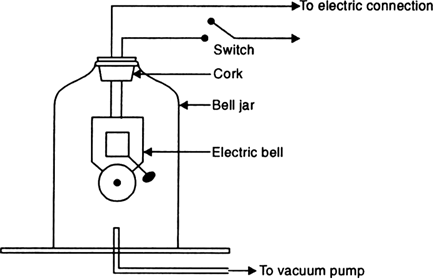
Fig. 12.9. Experiment showing sound needs a medium to travel.
When we turn on the switch, we hear the sound of the bell. Now, we pump out the air from the jar gradually with the help of the vacuum pump. The sound becomes fainter. When most of the air has been removed, we hear a very feeble sound.
When there is air inside the jar, sound travels through it to the wall of the jar. This makes the wall to vibrate which in turn, sends sound to us. When air is removed, sound from the bell cannot travel to the wall of the jar.
How can a longitudinal wave be represented graphically?
Graphical representation of a longitudinal wave. When a longitudinal wave passes through a medium, the particles of the medium alternately come closer together and move away from one another so that there are alternate regions of increased and decreased density. These regions are called compressions and rarefactions respectively. Fig. 12.12 (a) and (b) represent the density and pressure variations, respectively as a sound wave propagates through a medium. Fig. 12.12 (c) is the graphical representation of such a wave. It represents the variations of density as well as the pressure of the medium at a given time with distance, above and below the average value of density and pressure.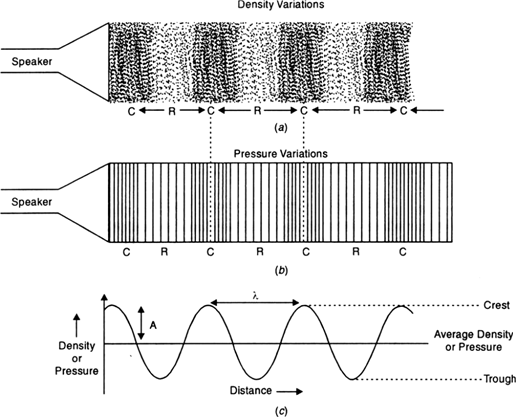
Fig. 12.12. Sound propagates as density or pressure variations as shown in (a), (b) and (c) represent graphically the density and pressure variations.
The distance between two successive compressions (C) or two rarefactions (R) is called wavelength. It is usually represented by λ (lambda).
Define the terms amplitude, intensity, time period, frequency, wavelength and velocity of a wave. Give their SI units.
Characteristics of sound waves. Like any other wave, sound waves are characterised by the following physical quantities:
(i) Amplitude. The maximum displacement suffered by the particles of the medium from their mean positions during the wave propagation is called ‘amplitude’ of the wave. It is denoted by A. Its SI unit is metre (m). Crests and troughs have amplitude A.
(ii) Intensity. The amount of sound energy passing each second through unit area is called the intensity of the sound wave. Larger the amplitude of a wave, larger is its intensity. In fact.

Fig. 12.13. Characteristics of a wave.
(iii) Time period. The time period of a wave is defined as the time in which a particle of the medium completes one vibration to and fro about its mean position. It is equal to the time taken by two successive compressions or rarefactions of a sound wave to cross a fixed point. It is represented by the symbol T. Its SI unit is second (s).
(iv) Frequency. The number of waves produced per second is called frequency of the wave. It is equal to the number of compressions or rarefactions crossing a point per unit time. It is denoted by v (nu). It is equal to the reciprocal of time period. Thus,
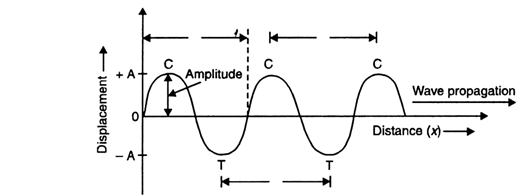
Wavelength. It is the distance travelled by the wave during the time a particle of the medium completes one vibration. It is equal to the distance between two successive crests or troughs or between two successive compressions and rarefactions and is denoted by λ (lambda). Its SI unit is metre (m).
Wave velocity. It is the distance travelled by a wave per unit time. It is the speed with which a disturbance (crest, trough, compression or rarefaction) propagates through a medium. Its SI unit is ms–1.
Q. 24. Define wave velocity, frequency and wavelength. Give SI unit of each term.
Wave velocity: Wave velocity is the distance travelled by a wave per unit time. It is the speed with which a disturbance of the particle like crest, trough, compression or rarefaction propagates through a medium.
Its SI unit is ms–1.
(iv) Frequency: The number of waves produced per second is called frequency of the wave. It is equal to the number of compressions or rarefactions crossing a point per unit time.
Symbolically, it is denoted by v (nu).
It is equal to the reciprocal of time period.
SI unit of frequency = hertz (Hz).
Wavelength: The distance between two successive crests or troughs or between two successive compressions and rarefactions is called the wavelength.
It is denoted by λ (lambda).
SI unit of wavelength is metre (m).
Explain the characteristics of sound. On what factors do they depend?
Characteristics of sound. The three characteristics of sound are (i) Loudness, (ii) Pitch and (iii) Quality or timbre.
(i) Loudness. Loudness is the physiological response of the ear to the intensity of sound. It distinguishes between a loud sound and low sound. Even when two sounds are of equal intensity, we may hear one as louder than the other because our ears detect it better than the other sound. Loudness depends on two main factors :
(a) Intensity of sound which is directly proportional to the square of the amplitude of the sound wave.
(b) Sensitivity of the ear.
Fig. 12.16 shows the wave shapes of a loud sound and a soft sound of the same frequency.
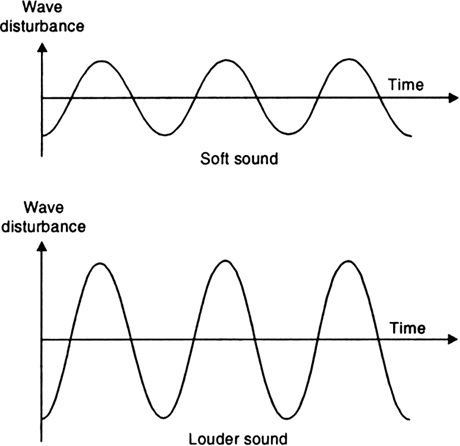
Fig. 12.16. Soft sound has small amplitude and louder sound has large amplitude.
(ii) Pitch. Pitch is the sensation which helps a listener to distinguish betwen a high and a grave note. Pitch depends on frequency. The faster the vibration of the source of sound, the higher is the frequency and higher is the pitch, as shown in Fig. 12.17. Thus a high pitch sound corresponds to more number of compressions and rarefactions passing a given point per unit time.
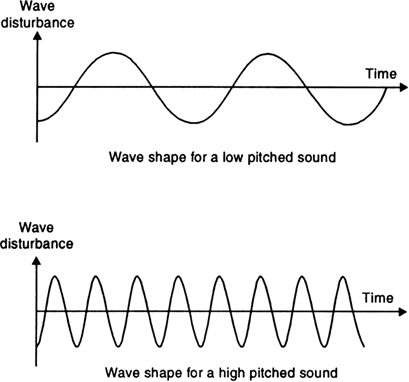
Fig. 12.17. Low pitch sound has low frequency and high pitch sound has high frequency.
The voice of a child or a lady is shriller than that of a man i.e., the pitch of a lady’s sound is higher than that of a man. The mosquito’s sound is of high frequency and hence high pitch.
(iii) Quality or timbre. The quality or timber of sound is that characteristic which enables us, to distinguish one sound from another having the same pitch and loudness. It is due to the quality of sound that one can recognise the voice of one’s friend without seeing him.
